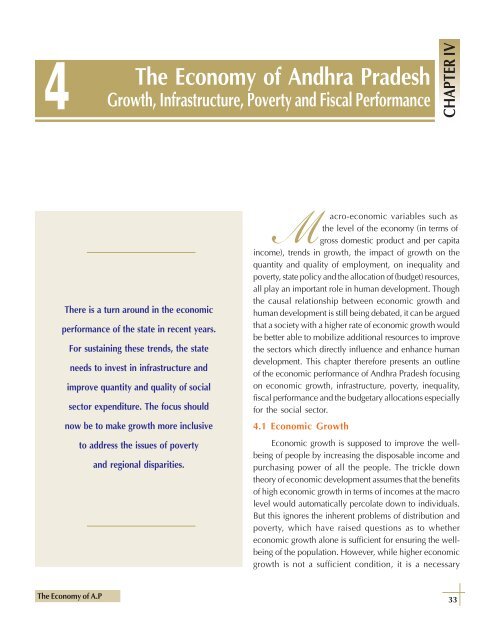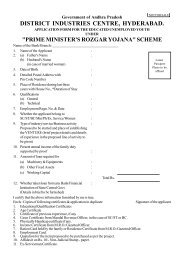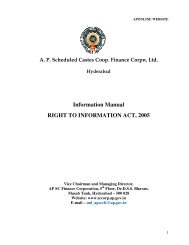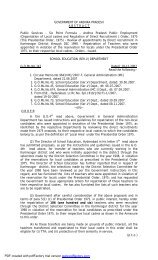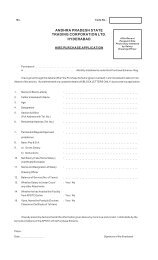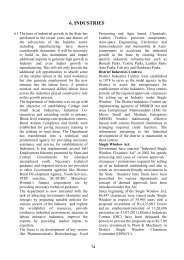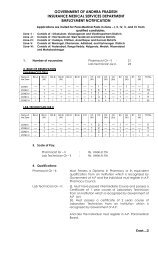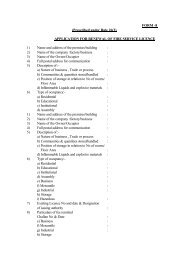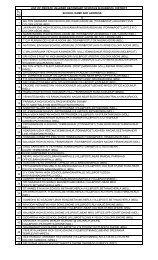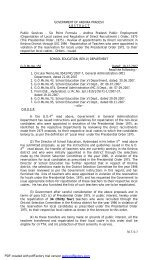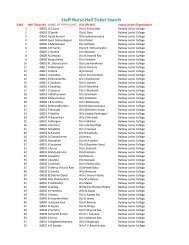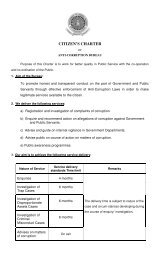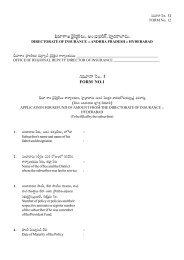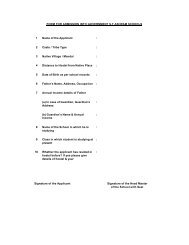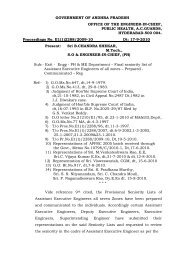The Economy of Andhra Pradesh - AP Online
The Economy of Andhra Pradesh - AP Online
The Economy of Andhra Pradesh - AP Online
You also want an ePaper? Increase the reach of your titles
YUMPU automatically turns print PDFs into web optimized ePapers that Google loves.
4<br />
<strong>The</strong> <strong>Economy</strong> <strong>of</strong> <strong>Andhra</strong> <strong>Pradesh</strong><br />
Growth, Infrastructure, Poverty and Fiscal Performance<br />
CH<strong>AP</strong>TER IV<br />
<strong>The</strong>re is a turn around in the economic<br />
performance <strong>of</strong> the state in recent years.<br />
For sustaining these trends, the state<br />
needs to invest in infrastructure and<br />
improve quantity and quality <strong>of</strong> social<br />
sector expenditure. <strong>The</strong> focus should<br />
now be to make growth more inclusive<br />
to address the issues <strong>of</strong> poverty<br />
and regional disparities.<br />
M<br />
acro-economic variables such as<br />
the level <strong>of</strong> the economy (in terms <strong>of</strong><br />
gross domestic product and per capita<br />
income), trends in growth, the impact <strong>of</strong> growth on the<br />
quantity and quality <strong>of</strong> employment, on inequality and<br />
poverty, state policy and the allocation <strong>of</strong> (budget) resources,<br />
all play an important role in human development. Though<br />
the causal relationship between economic growth and<br />
human development is still being debated, it can be argued<br />
that a society with a higher rate <strong>of</strong> economic growth would<br />
be better able to mobilize additional resources to improve<br />
the sectors which directly influence and enhance human<br />
development. This chapter therefore presents an outline<br />
<strong>of</strong> the economic performance <strong>of</strong> <strong>Andhra</strong> <strong>Pradesh</strong> focusing<br />
on economic growth, infrastructure, poverty, inequality,<br />
fiscal performance and the budgetary allocations especially<br />
for the social sector.<br />
4.1 Economic Growth<br />
Economic growth is supposed to improve the wellbeing<br />
<strong>of</strong> people by increasing the disposable income and<br />
purchasing power <strong>of</strong> all the people. <strong>The</strong> trickle down<br />
theory <strong>of</strong> economic development assumes that the benefits<br />
<strong>of</strong> high economic growth in terms <strong>of</strong> incomes at the macro<br />
level would automatically percolate down to individuals.<br />
But this ignores the inherent problems <strong>of</strong> distribution and<br />
poverty, which have raised questions as to whether<br />
economic growth alone is sufficient for ensuring the wellbeing<br />
<strong>of</strong> the population. However, while higher economic<br />
growth is not a sufficient condition, it is a necessary<br />
<strong>The</strong> <strong>Economy</strong> <strong>of</strong> A.P<br />
33
condition for improving human development for several<br />
reasons, first because it creates greater opportunities for<br />
employment and rising incomes, and, more important,<br />
because higher growth would generate more resources<br />
which may be available for further investments in social<br />
development.<br />
4.1.1 ‘Turn Around’ in Economic Growth<br />
India broke out <strong>of</strong> the trap <strong>of</strong> a low rate <strong>of</strong> economic<br />
growth, the ‘Hindu rate <strong>of</strong> growth’, by the 1980s. If the<br />
performance <strong>of</strong> <strong>Andhra</strong> <strong>Pradesh</strong> is compared to all-India<br />
and other states, it is seen that GSDPgrowth rates for A.P.<br />
also rose beyond the earlier low rates during the last two<br />
and half decades. GSDPgrew continuously from 2.11 per<br />
cent in the 1960s to 3.03 percent in the 1970s; to 5.21<br />
per cent in the 1980s and to 5.42 per cent in the 1990s<br />
(Table 4.1) 1 . It was 5.89 per cent in the first five years <strong>of</strong><br />
this decade. However, the growth <strong>of</strong> GSDPin the last ten<br />
years (1993-94 to 2003-04) was lower at 5.66 per cent<br />
as compared to 5.93 per cent during the decade 1984-<br />
85 to 1993-94. <strong>The</strong> growth rate <strong>of</strong> GSDP was lower in<br />
A.P. than the all-India rate but has been catching up over<br />
Table 4.1: Trend Rate <strong>of</strong> Growth in GSDP and Per<br />
Capita GSDP: <strong>AP</strong> and All-India<br />
Year<br />
<strong>AP</strong><br />
India<br />
GSDP Per Capita GDP Per Capita<br />
1 2 3 4 5<br />
1960-61 to 1970-71 2.11 0.26 3.43 1.23<br />
1970-71 to 1980-81 3.02 0.94 3.38 1.12<br />
1980-81 to 1990-91 5.21 3.04 5.37 3.24<br />
1990-91 to 2000-01 5.42 4.01 5.94 3.98<br />
2000-01 to 2004-05 5.89 4.83 6.08 4.37<br />
1983-84 to 1993-94 5.93 3.85 5.23 3.14<br />
1993-94 to 2003-04 5.66 4.46 5.83 3.98<br />
Note : At constant (1993-94) prices.<br />
Source : New Series (1993-94) GSDP, Directorate <strong>of</strong> Economics and Statistics<br />
(DES), Hyderabad<br />
1<br />
<strong>The</strong> GSDP figures used were supplied by the Directorate <strong>of</strong> Economics and<br />
Statistics <strong>of</strong> <strong>Andhra</strong> <strong>Pradesh</strong>, Hyderabad. Whole series <strong>of</strong> data from 1960 to<br />
the latest has been transformed into latest single base year: i.e. 1993-94<br />
prices. While bringing GSDP figures at Constant prices with different base<br />
years into a single one, splicing method is used at the disaggregated level (i.e.<br />
Splicing is done for each individual sector). All this is done by DES, Hyderbad<br />
and supplied the final data.<br />
time. Moreover, there seems to have been a turnaround<br />
in the growth <strong>of</strong> GSDP in A.P. in the last five years. <strong>The</strong><br />
average annual growth rate was 7.45 per cent during 2001-<br />
08 and 8.7 percent during 2004-08 (Table 4.1a). <strong>The</strong><br />
annual average growth in <strong>AP</strong> is higher than that <strong>of</strong> India<br />
in 2007-08.<br />
Table 4.1a: Annual Growth (%) <strong>of</strong> GSDP<br />
Year <strong>AP</strong> India<br />
1 2 3<br />
2001-02 4.20 5.81<br />
2002-03 3.26 3.84<br />
2003-04 9.27 8.52<br />
2004-05 (R) 6.96 7.45<br />
2005-06 (P) 8.72 9.40<br />
2006-07 (Q) 8.87 9.62<br />
2007-08 (A) 10.37 8.73<br />
Average <strong>of</strong> 2004-5 to 2007-8 8.73 8.80<br />
Average <strong>of</strong> 2001-2 to 2007-8 7.45 7.22<br />
Note : 1. Constant (1999-2000) Prices; 2. Annual Growth is<br />
percentage change over previous year; 3. R–Revised;<br />
P-Provisional; Q–Quick; A–Advanced.<br />
Source : Planning Department, GO<strong>AP</strong>.<br />
Average per capita GSDP has increased from Rs. 4422<br />
(decadal average) in the 1960s to Rs. 8865 in the 1990s.<br />
Recent estimates show that it has further increased to<br />
Rs. 12804 during 2001-06 (Table 4.2). Though per capita<br />
income in the state has always been lower than the all-<br />
India average, the ratio <strong>of</strong> A.P. to all-India per capita net<br />
SDP rose from 95.7 per cent in the triennium 1993-96 to<br />
99.3 per cent in 2002-05. <strong>The</strong> level <strong>of</strong> per capita GSDP<br />
in <strong>Andhra</strong> <strong>Pradesh</strong> is now almost equal to the all-India<br />
average (Figure 4.1). Thus, A.P. seems to have caught up<br />
with all-India in per capita income in recent years. <strong>The</strong><br />
Table 4.2: Decadal Averages <strong>of</strong> Per Capita GSDP in <strong>AP</strong> and India<br />
Period <strong>AP</strong> India Ratio (<strong>AP</strong>/India)<br />
1 2 3 4<br />
1960s 4422 4965 89.1<br />
1970s 4904 5575 88.0<br />
1980s 6160 6788 90.7<br />
1990s 8865 9587 92.5<br />
2001-06 12804 13058 98.1<br />
Note : Averages <strong>of</strong> decades in Constant (1993-94) prices.<br />
Source : Computed based on the DES Figures.<br />
34<br />
<strong>Andhra</strong> <strong>Pradesh</strong> Human Development Report 2007
growth rate <strong>of</strong> per capita GSDP has also increased<br />
significantly over time from 2.8 percent in the 80s to 3.9<br />
percent in the 90s and to 4.8 per cent during 2000-05<br />
(Table 4.1). In the last five years it has grown at about 5<br />
per cent per annum, which was slightly higher than the<br />
all-India rate for the same period. This high growth was<br />
partly due to lower population growth in A.P. than all-<br />
India.<br />
In comparison with other states, <strong>Andhra</strong> <strong>Pradesh</strong><br />
was one <strong>of</strong> the top performing states in terms <strong>of</strong> GSDP<br />
growth in the 1980s. Only three states viz., Rajasthan,<br />
Haryana, and Maharashtra showed higher growth than<br />
<strong>Andhra</strong> <strong>Pradesh</strong> in the 1980s. However, in the 1990s,<br />
A.P. was ranked eighth in terms <strong>of</strong> GSDP growth. Apart<br />
from the above three states, Gujarat, Karnataka, Tamil<br />
Nadu and West Bengal had a higher rate <strong>of</strong> growth than<br />
Per Capita (Rs.)<br />
16000<br />
14000<br />
12000<br />
10000<br />
8000<br />
6000<br />
4000<br />
2000<br />
Figure 4.1: Per Capita GSDP in <strong>AP</strong> and India<br />
and the Ratio <strong>of</strong> <strong>AP</strong> in All India<br />
0<br />
<strong>AP</strong><br />
India<br />
India<br />
Ratio (<strong>AP</strong>)<br />
1960-61<br />
1962-63<br />
1964-65<br />
1966-67<br />
1968-69<br />
1970-71<br />
1972-73<br />
1974-75<br />
1976-77<br />
1978-79<br />
1980-81<br />
1982-83<br />
1984-85<br />
1986-87<br />
1988-89<br />
1990-91<br />
1992-93<br />
1994-95<br />
1996-97<br />
1998-99<br />
2000-1<br />
2002-3<br />
2004-5<br />
120.0<br />
100.0<br />
<strong>Andhra</strong> <strong>Pradesh</strong> in the 1990s. Similar trends can be seen<br />
for the growth <strong>of</strong> per capita income in the1990s across<br />
states. <strong>The</strong> state’s (A.P) rank in per capita GSDP growth<br />
was lower in the 1990s as compared to the1980s.<br />
From 1993-94 to 2004-05, the annual growth <strong>of</strong> GSDP<br />
in A.P. was 5.74 per cent and 4.7 per cent for per capita<br />
GSDP. During this period A.P. ranked seventh in GSDP<br />
growth and fifth in per capita GSDP growth among eighteen<br />
major states. It shows that A.P. has done relatively well<br />
in terms <strong>of</strong> growth if we include data from recent years.<br />
<strong>The</strong> sectoral composition <strong>of</strong> GSDP in <strong>Andhra</strong> <strong>Pradesh</strong><br />
shows that while the primary sector contribution has been<br />
80.0<br />
60.0<br />
40.0<br />
20.0<br />
0.0<br />
Ratio (%)<br />
Per cent<br />
55<br />
50<br />
45<br />
40<br />
35<br />
30<br />
25<br />
20<br />
15<br />
Figure 4.2: Change in Sectoral Contribution<br />
(in %) <strong>of</strong> GSDP in <strong>AP</strong><br />
Primary (excl. M&Q)<br />
Second (incl. M &Q)<br />
Tertiary<br />
1980-81<br />
1981-82<br />
1982-83<br />
1983-84<br />
1984-85<br />
1985-86<br />
1986-87<br />
1987-88<br />
1988-89<br />
1989-90<br />
1990-91<br />
1991-92<br />
1992-93<br />
1993-94<br />
1994-95<br />
1995-96<br />
1996-97<br />
1997-98<br />
1999-2000<br />
2000-1<br />
2001-2<br />
2002-3<br />
2003-4<br />
2004-5<br />
2005-6<br />
declining continuously (from 45 per cent in 1980-81 to<br />
24 per cent in 2004-05), there has been a corresponding<br />
increase in both the secondary (19 to 25 per cent) and<br />
tertiary (35 to 50 per cent) sectors, though the growth <strong>of</strong><br />
the latter is much higher (Figure 4.2).<br />
<strong>The</strong> growth rate <strong>of</strong> GSDP across the sectors indicates that<br />
the primary sector registered the lowest rate <strong>of</strong> growth in<br />
<strong>Andhra</strong> <strong>Pradesh</strong> (Table 4.3). However, the primary sector<br />
had its highest ever rate <strong>of</strong> growth (3.32 per cent) in the<br />
1990s. <strong>The</strong> tertiary sector registered the highest growth<br />
rate during the 1980s and in the recent past but in the<br />
1990s the secondary sector (6.76 per cent) had grown at<br />
Table 4.3: Sectoral Trend Growth (in %) in A P<br />
1980-81 to 1990-91 to 2000-01 to<br />
Industry Group<br />
1990-91 2000-01 2004-05<br />
1 2 3 4<br />
Primary 2.30 3.32 2.07<br />
(2.13) (3.01) (1.41)<br />
Secondary 6.92 6.70 7.11<br />
(6.84) (6.77) (7.24)<br />
Manufacturing (Reg) 9.87 6.76 7.73<br />
Manufacturing<br />
(Un-Reg) 5.47 6.98 4.87<br />
Tertiary 7.63 6.33 7.63<br />
GSDP 5.20 5.41 5.89<br />
Note : 1. Usually Primary includes Mining and Quarrying (M&Q),<br />
figures in parenthesis indicates when M&Q is excluded<br />
from Primary sector and included in Secondary; 2. Secondary<br />
sector includes Manufacturing (Reg.&Un-Reg) and others.<br />
Source : DES, Hyderabad.<br />
<strong>The</strong> <strong>Economy</strong> <strong>of</strong> A.P<br />
35
the highest rate. <strong>The</strong> manufacturing sector, particularly<br />
the organized/registered sector, performed relatively better<br />
than any other sector. In the last four years growth rates<br />
for primary, secondary and tertiary sectors respectively<br />
were 2.6 per cent, 7 to 8 per cent and, 8 to 9 per cent per<br />
annum.<br />
Within the primary sector, agriculture (including crop<br />
production and livestock) registered the lowest growth.<br />
<strong>Andhra</strong> <strong>Pradesh</strong> was among the very few states in the<br />
country which experienced for the Green Revolution,<br />
especially in respect <strong>of</strong> rice, in the 1970s. <strong>The</strong> growth<br />
rate <strong>of</strong> the agricultural sector increased till the 1980s but<br />
it declined subsequently. In the first five years (2000-05)<br />
<strong>of</strong> this decade, growth <strong>of</strong> GSDP in agriculture was less<br />
than one per cent per annum. Agricultural growth in the<br />
first four decades (1960s to 1990s) was lower in A.P. as<br />
compared to all-India. Within agriculture, the share <strong>of</strong><br />
livestock has been increasing over time and now it<br />
contributes almost 85 per cent <strong>of</strong> the growth in agriculture.<br />
<strong>The</strong> contribution <strong>of</strong> the non-agricultural sector to<br />
total GSDP has been increasing continuously over a period<br />
in the state as well as all-India. It has increased from 50<br />
per cent in the 1960s to 79 percent in 2005-06 in the<br />
state. Moreover, as the growth in agriculture has been at<br />
a minimal level, most <strong>of</strong> the growth in the overall economy<br />
has been due to the growth in non-agriculture. In contrast<br />
to overall growth, the growth in the non-agricultural sector<br />
<strong>of</strong> the state has always been relatively higher than the<br />
all-India average, except in the 1990s.<br />
Table 4.4: Per Capita GSDP per Worker (in Rs)<br />
in Agriculture and Non-agriculture Activities<br />
Year<br />
<strong>Andhra</strong> <strong>Pradesh</strong> All-India<br />
Agrl Non-Agrl Gap Agrl Non-Agrl Gap<br />
1 2 3 4 5 6 7<br />
1993 7201 34077 26876 9327 41783 32456<br />
2003 9830 51924 42094 11058 62854 51796<br />
% Change 36.5 52.4 15.9 18.6 50.4 31.9<br />
Note : 1. Workers in Agrl (agriculture) and Non-Agrl (nonagriculture)<br />
considered to calculate the per capita GSDP<br />
per worker, is based on NSSO 50 th (1993-94) and 61 st<br />
(2004-05) round and New Series (1993-94) GSDP figures<br />
<strong>of</strong> DES (Hyderabad).<br />
Source : Computed.<br />
Since GSDP has been growing without a corresponding<br />
increase in the level <strong>of</strong> employment, the gap in per capita<br />
value added per worker between those engaged in<br />
agriculture and non-agriculture has increased significantly<br />
over time. For instance, the per capita GSDP value added<br />
in agriculture (including agriculture related activities) per<br />
worker was Rs. 7201 in 1993-94 which increased to Rs.<br />
9830 in 2004-05, an increase <strong>of</strong> 36.5 per cent (Table<br />
4.4). On the other hand, the per capita GSDP value added<br />
in non-agriculture per worker increased by about 52.4<br />
per cent from Rs. 34077 to Rs. 51924 during the same<br />
period. <strong>The</strong> gap between agriculture and non-agriculture<br />
in terms <strong>of</strong> per capita value added per worker has increased<br />
from Rs. 26876 to Rs. 42094. Unless the high growth in<br />
GSDP <strong>of</strong> non-agriculture results in a corresponding growth<br />
in employment by absorbing the surplus labour in<br />
agriculture, it may not result in an improvement in the<br />
conditions <strong>of</strong> the poor and thereby human development.<br />
<strong>The</strong>refore, it will result in lopsided growth/development.<br />
4.1.2 Regional Disparities in the Levels and Growth <strong>of</strong><br />
the <strong>Economy</strong><br />
<strong>The</strong> challenge <strong>of</strong> development policy in the period<br />
subsequent to the formation <strong>of</strong> the state was to integrate<br />
different diverse regions into a single economic entity<br />
and to accelerate the growth <strong>of</strong> its productive sectors,<br />
along with the promotion <strong>of</strong> adequate opportunities to<br />
36<br />
<strong>Andhra</strong> <strong>Pradesh</strong> Human Development Report 2007
Box 4.1: Information Technology in A P<br />
Information Technology (IT) services is the fastest growing component <strong>of</strong> the service sector in India and <strong>Andhra</strong> <strong>Pradesh</strong>. At<br />
present <strong>Andhra</strong> <strong>Pradesh</strong> ranks fourth in s<strong>of</strong>tware exports from India, behind Karnataka, Maharashtra and Tamil Nadu. Hyderabad is<br />
the major destination for IT companies. <strong>The</strong> S<strong>of</strong>tware Technology Park Hyderabad (STPIH) was started in 1991. Efforts are underway<br />
to take the IT sector to other Tier-II cities viz., Visakhapatnam, Vijayawada, Tirupati, Warangal and Kakinada. Efforts to develop Tier-II<br />
cities were started in 2001-02 but do not seem to have been successful as yet. In 2006-07, Visakhapatnam, Vijayawada and Tirupati<br />
accounted for only 1.55 percent <strong>of</strong> total exports <strong>of</strong> IT sector from <strong>Andhra</strong> <strong>Pradesh</strong>.<br />
<strong>The</strong> number <strong>of</strong> units registered under STPIH was only 7 in the year 1991-92 but rose to 194 in 1998-99. 1999-2000 saw a<br />
quantum jump with the number units going up to 977. It continued to rise 2 to 1401 in 2002-03. <strong>The</strong>re were 1408 registered units<br />
under STPIH in 2006-07.<br />
Exports <strong>of</strong> IT sector firms registered with S<strong>of</strong>tware Technology Park in Hyderabad (STPIH) started at a very low level <strong>of</strong> Rs.0.02<br />
crores in 1991-92. <strong>The</strong>y reached Rs.574 crores in 1998-99 and Rs.18582 crores in 2006-07. <strong>The</strong>re has been very rapid growth in<br />
overall IT exports especially in the past four years, but it must be noted that the growth rates in later years are over a larger base. Even<br />
with this performance, the share <strong>of</strong> <strong>AP</strong> in total Indian exports <strong>of</strong> IT reached only 13.10 percent in 2006-07 from 7.96 percent in 2002-<br />
03. As already mentioned <strong>AP</strong> ranks fourth among the states in IT exports. Most <strong>of</strong> the increase in later years seems to be the contribution<br />
<strong>of</strong> ITES instead <strong>of</strong> IT. <strong>The</strong> share <strong>of</strong> ITES, which was only 0.34 percent <strong>of</strong> exports in 1999-00, rose to 39.16 percent in 2002-03<br />
(Ramachandriah, 2003: 209), and reached 56.00 percent in 2006-07 (<strong>The</strong> Economic Times, May 30, 2007).<br />
ensure broad-based participation by all sections <strong>of</strong> society 3 .<br />
However, the actual performance <strong>of</strong> the economy indicates<br />
that the response <strong>of</strong> the state government to this challenge<br />
has not been very satisfactory.<br />
Even after fifty years, regional disparities in economic<br />
and social development are significant in A.P. A comparison<br />
<strong>of</strong> growth rates 4 <strong>of</strong> district domestic product (DDP) and<br />
per capita DDP shows that seven districts <strong>of</strong> Telangana<br />
(Ranga Reddy, Nizamabad, Khammam, Hyderabad,<br />
Mahabubnagar, Warangal and Medak) and two districts<br />
<strong>of</strong> North Coastal <strong>Andhra</strong> (Visakhapatnam and Srikakulam)<br />
have had higher growth rates than the state average. On<br />
the other hand, all the districts in South Coastal <strong>Andhra</strong><br />
and Rayalaseema and three districts <strong>of</strong> Telangana and<br />
one district <strong>of</strong> North Coastal <strong>Andhra</strong> have had a lower<br />
growth than the state average. In terms <strong>of</strong> per capita income,<br />
the distance between the poorest four districts and the<br />
2<br />
Data on units is not a very reliable indicator <strong>of</strong> the strength <strong>of</strong> the IT<br />
sector in <strong>AP</strong>. At any time the number <strong>of</strong> units reflects the number <strong>of</strong> units<br />
registered with STPIH, and not those which are functional. In fact in<br />
2003-04 the number <strong>of</strong> units registered has come down because a number<br />
<strong>of</strong> units have been de-registered since they had not been reporting<br />
any activity for more than three years.<br />
3<br />
See Rao et al, (1998). For some useful references on the historical factors and<br />
developments in A.P. in the earlier decades see Mukund (1990), Radhakrishna<br />
(1990), Parthasarathy (1995), Vithal (1998).<br />
4<br />
<strong>The</strong> Directorate <strong>of</strong> Economics and Statistics provides domestic product for<br />
each district in the state. <strong>The</strong>se are available for the recent period 1993-94 to<br />
2003-04.<br />
richest four districts has declined between 1993-94 and<br />
2003-04. <strong>The</strong> ratio <strong>of</strong> the four poorest districts (Srikakulam,<br />
Warangal, Mahabubnagar and Vizianagaram) to the four<br />
richest districts (Ranga Reddy, Medak, Nellore and Krishna)<br />
increased from 57.4 per cent in 1993-94 to 65.5 percent<br />
in 2003-04.<br />
Per Capita DDP (Rs.)<br />
Figure 4.3: Per Capita GDDP and its Rate <strong>of</strong> Growth<br />
across Districts <strong>of</strong> <strong>Andhra</strong> <strong>Pradesh</strong><br />
30000<br />
25000<br />
20000<br />
15000<br />
10000<br />
5000<br />
0<br />
1993-94<br />
Growth<br />
2004-05<br />
Srikakulam<br />
Vizianagaram<br />
Visakhapatnam<br />
East Godavari<br />
West Godavari<br />
Krishna<br />
Guntur<br />
Prakasam<br />
Nellore<br />
Chittoor<br />
kadapa<br />
Ananthapur<br />
Kurnool<br />
Mahabubnagar<br />
Ranga Reddy<br />
Hyderabad<br />
Medak<br />
Nizamabad<br />
Adilabad<br />
Karimnagar<br />
Warangal<br />
Khammam<br />
Nalgonda<br />
<strong>Andhra</strong> <strong>Pradesh</strong><br />
7.0<br />
6.0<br />
5.0<br />
4.0<br />
3.0<br />
2.0<br />
1.0<br />
0.0<br />
If one analyses the relationship between the levels<br />
<strong>of</strong> per capita income in the base year and growth rates <strong>of</strong><br />
DDP and per capita DDP, it can be seen that in some<br />
districts the higher growth rates could be due to a low<br />
base (Figure 4.3). However, in the nine districts which<br />
recorded higher growth rates than the state average in<br />
per capita income, only four districts (Mahabubnagar,<br />
Nizamabad, Warangal and Srikakulam) had a low base.<br />
It may be noted that the quality <strong>of</strong> growth is important.<br />
Growth (%)<br />
<strong>The</strong> <strong>Economy</strong> <strong>of</strong> A.P<br />
37
Some <strong>of</strong> the Telangana districts may be showing higher<br />
growth rates but we are not sure about the quality <strong>of</strong><br />
growth. We are also not sure whether it is inclusive growth<br />
in this region. Further research is needed to understand<br />
the impact <strong>of</strong> growth in Telangana and some other regions.<br />
Secondly, there are significant disparities in social<br />
development.<br />
Despite some favourable trends in district domestic<br />
product, regional disparities in the levels <strong>of</strong> development<br />
are still significant in the state 5 . For example, South Coastal<br />
<strong>Andhra</strong>, because <strong>of</strong> the very high level <strong>of</strong> assured sources<br />
<strong>of</strong> irrigation, continues to occupy the top position in regard<br />
to agricultural output per hectare, followed by North<br />
Telangana and North Coastal <strong>Andhra</strong>. Rayalaseema and<br />
South Telangana are at the bottom because <strong>of</strong> insufficient<br />
irrigation coupled with low and erratic rainfall. Moreover,<br />
well irrigation is predominant in Telangana and Rayalaseema,<br />
entailing high cost <strong>of</strong> power for pumping water, besides<br />
exposing the rural areas to the uncertainties <strong>of</strong> weather<br />
and shortage <strong>of</strong> drinking water. As shown in subsequent<br />
chapters, disparities in education and health across regions<br />
are quite high.<br />
4.2 Infrastructure<br />
Physical and social infrastructure is important for<br />
economic growth and higher human development.<br />
Economic infrastructure like transport 6 , communication<br />
and power facilitates the growth <strong>of</strong> economic activities<br />
and contributes to national or state GDP through revenue<br />
mobilization. In <strong>Andhra</strong> <strong>Pradesh</strong> the contribution <strong>of</strong> the<br />
transport and communication sector to total Gross State<br />
Domestic Product at current prices was 6.31 per cent in<br />
1960-61 and increased to 7.94 per cent in 2004-05 (DES,<br />
2005).<br />
<strong>The</strong> total road length in <strong>Andhra</strong> <strong>Pradesh</strong> in 1956-<br />
57 was 17086 Kms (consisting <strong>of</strong> 338 Kms <strong>of</strong> cement<br />
concrete, 5016 Kms <strong>of</strong> blacktop, 10939 Kms <strong>of</strong> metalled<br />
and 793 Kms <strong>of</strong> unmetalled roads) which was 6.21 Kms<br />
per 100 Sq. Kms in the state and 0.55 Kms per 1000<br />
population. <strong>The</strong> total road length increased to 179980<br />
5<br />
See Rao (2007) on the failure <strong>of</strong> successive governments to address regional<br />
imbalances in the state.<br />
6<br />
<strong>The</strong> modern transport system consists <strong>of</strong> surface (Rail and Road), water<br />
(Navigation) and air transport.<br />
Kms by the year 2002-03, a phenomenal increase <strong>of</strong> 954<br />
percent over the period, about 65.45 Kms per 100 sq<br />
kms <strong>of</strong> geographical area and 2.36 kms per 1000<br />
population. In 1956-7 the total length <strong>of</strong> railway lines in<br />
<strong>Andhra</strong> <strong>Pradesh</strong> was 4550 Kms which has gradually<br />
increased to 4974 Kms.<br />
Since the inception <strong>of</strong> the first Five Year Plan,<br />
investment in irrigation has been a priority in the state to<br />
increase agricultural growth. For about three decades from<br />
the 1950s to the 1970s, irrigation has accounted for a<br />
major share <strong>of</strong> public expenditure in <strong>Andhra</strong> <strong>Pradesh</strong>.<br />
During the pre-plan period, 27.02 lakh hectares <strong>of</strong> ayacut<br />
was developed. About Rs. 18771.36 crores were spent<br />
from the First Plan till 2004-05 and irrigation potential<br />
<strong>of</strong> 27.67 lakh hectares was created. <strong>The</strong> total area irrigated<br />
(gross) was 136.36 lakh acres, or about 40 per cent <strong>of</strong><br />
the gross cropped area in the state as on August 2005.<br />
<strong>Andhra</strong> <strong>Pradesh</strong> has been one <strong>of</strong> the major Indian states<br />
with the highest percentage <strong>of</strong> area under irrigation. <strong>The</strong><br />
rapid growth in area under irrigation in the state till the<br />
1980s was reversed during the 1990s and thereafter. More<br />
recently, irrigation has again become a priority in state<br />
policy and a considerable amount <strong>of</strong> resources has been<br />
earmarked under the policy initiative Jalayagnam. <strong>The</strong><br />
amount and percentage <strong>of</strong> expenditure on Irrigation and<br />
Flood Control has been the highest among Indian states.<br />
Given the longer gestation period <strong>of</strong> major irrigation<br />
projects, the expected results <strong>of</strong> this policy initiative will<br />
take time to evaluate.<br />
Another important sector that had gained attention<br />
and priority in resource allocation from policy makers<br />
during the 1950s to 70s was the power/electricity sector.<br />
38<br />
<strong>Andhra</strong> <strong>Pradesh</strong> Human Development Report 2007
As a result, the installed capacity <strong>of</strong> the power sector<br />
increased from 213 MW to 11105 MW between 1959<br />
and 2005. <strong>The</strong> total number <strong>of</strong> consumers has grown<br />
from 2.7 to 165.48 lakhs and the energy handled per<br />
annum rose from 686 MU to 51123 MU during the same<br />
period. <strong>The</strong> annual revenue increased from Rs.5.50 crores<br />
to Rs. 10170 crores. Of the total installed capacity about<br />
27 per cent is from thermal and 32 per cent from hydel<br />
units. Power generation during 2004-05 was 51122.82<br />
MKWH. <strong>The</strong> state had the highest gross generation, next<br />
to Maharashtra and Goa. Of the total power generated<br />
in the state about 40 per cent was from thermal units<br />
and another 10 per cent from the hydel units. <strong>The</strong> rest<br />
was the contribution <strong>of</strong> others that include the central<br />
sector projects and purchases from other states and the<br />
private sector. Though the power sector <strong>of</strong> the state emerged<br />
as the one <strong>of</strong> the best performers in India, power generation<br />
in the state was insufficient to meet the demand. Per capita<br />
consumption <strong>of</strong> electricity has increased over the period<br />
to 574 KWh during 2004-05. <strong>The</strong> state is among the top<br />
ten states in terms <strong>of</strong> per capita consumption <strong>of</strong> electricity.<br />
<strong>Andhra</strong> <strong>Pradesh</strong> is one <strong>of</strong> the states in which almost<br />
all the villages are electrified. This has to be read with<br />
the caution that this does not ensure either that each hamlet<br />
in every village is electrified or that each household in<br />
every village/hamlet has electricity. <strong>The</strong> figures show that<br />
about 94 per cent <strong>of</strong> the habitats/hamlets in the state were<br />
electrified and 69 per cent <strong>of</strong> the rural households had<br />
electricity connection in 2005.<br />
Agriculture, particularly irrigation, in <strong>Andhra</strong> <strong>Pradesh</strong>,<br />
is the single largest consumer <strong>of</strong> electricity; per capita<br />
consumption <strong>of</strong> electricity (utility) was highest in this sector.<br />
<strong>The</strong> number <strong>of</strong> agricultural services in the state increased<br />
from about four thousand in the late 1950s to three lakhs<br />
by the end <strong>of</strong> the Fifth Plan and to 24 crores by the end<br />
<strong>of</strong> 2005. <strong>Andhra</strong> <strong>Pradesh</strong> was the second highest among<br />
the Indian states in terms <strong>of</strong> number <strong>of</strong> agricultural services.<br />
<strong>The</strong> number <strong>of</strong> pump sets energized through electricity<br />
in <strong>Andhra</strong> <strong>Pradesh</strong> was around 23 lakhs (as on 31 st March<br />
2005), which is the second highest after Maharashtra.<br />
<strong>The</strong> power shortage is considered to be one <strong>of</strong> the<br />
contributing factors in the agrarian crisis in the state.<br />
In <strong>Andhra</strong> <strong>Pradesh</strong>, there were 16190 post <strong>of</strong>fices<br />
and 32.64 lakh telephone connections as on March 2005,<br />
that is, around 21 post <strong>of</strong>fices and 4121 telephone<br />
connection per lakh population. <strong>The</strong> number <strong>of</strong> scheduled<br />
commercial bank branches in the state was 5415 at the<br />
end <strong>of</strong> the year 2005, that is about 7 bank braches per<br />
lakh population or 14 thousand persons per bank branch.<br />
<strong>The</strong> aggregate deposits in these commercial banks<br />
amounted to Rs. 98600 crores, or Rs. 1420 per capita.<br />
Total bank credit advanced was Rs. 74771 crores, or Rs.<br />
11428 per capita. <strong>The</strong> state ranks fourteenth among the<br />
Indian states in terms <strong>of</strong> both the population per bank<br />
and per capita deposit whereas in terms <strong>of</strong> per capita<br />
credit it stands seventh.<br />
Despite improvements in infrastructure in the state,<br />
the Infrastructure index 7 presented in the report <strong>of</strong> the<br />
Tenth and Eleventh Finance Commission for major Indian<br />
states shows that though the index value for <strong>Andhra</strong> <strong>Pradesh</strong><br />
for 1995 was almost close to all-India (i.e. 100) it was<br />
only ranked at 10 among the fifteen major states. In 2000,<br />
the index value and rank <strong>of</strong> the state had improved<br />
marginally to 103 and 9 respectively. Punjab, Kerala, Tamil<br />
Nadu, Haryana and Gujarat had much higher levels <strong>of</strong><br />
infrastructure than <strong>Andhra</strong> <strong>Pradesh</strong> in the year 2000.<br />
<strong>The</strong>re are wide disparities in terms <strong>of</strong> infrastructure<br />
facilities across the districts in the state. With respect to<br />
irrigation, the percentage <strong>of</strong> gross irrigated area varied<br />
from as low as 13 per cent in Adilabad to 87 per cent in<br />
West Godavari in 2001. Across all the districts in the<br />
state almost all the villages are electrified, though as noted<br />
above, this does not mean that all households have electric<br />
connections. Bank branches and telephone connections<br />
7<br />
<strong>The</strong> index for each state is estimated in relation to all-India<br />
<strong>The</strong> <strong>Economy</strong> <strong>of</strong> A.P<br />
39
are heavily concentrated (16 bank branches and 12617<br />
telephones per lakh population) in Hyderabad which in<br />
fact is entirely urbanized. <strong>The</strong> variation across other districts<br />
in terms <strong>of</strong> bank branches is not very high (from 5 to 8).<br />
Road infrastructure ranges from 497 to 973 km per thousand<br />
square km (<strong>of</strong> geographical area) across districts in the<br />
state. Hyderabad (973) followed by Srikakulam, West<br />
Godavari, Krishna and Rangareddy (793) have the highest<br />
road density.<br />
<strong>The</strong> composite index representing the selected<br />
infrastructure facilities across districts in the state is in<br />
relation to the state average. <strong>The</strong> index indicates the status<br />
<strong>of</strong> an individual district in comparison with the state average.<br />
If the index value <strong>of</strong> any district is above 1 it shows better<br />
infrastructure than the state average and vice versa. For<br />
instance, Hyderabad (10.2) would be the best performing<br />
district in terms <strong>of</strong> infrastructure and Mahabubnagar (0.73)<br />
would be the most backward. <strong>The</strong> index values in general<br />
indicate that most <strong>of</strong> the districts performing below the<br />
state average are located in Telangana, Rayalaseema (see<br />
Figure 4.4).<br />
Figure 4.4 : Infrastructure Index, 2004<br />
<strong>AP</strong><br />
Hyderabad<br />
West Godavari<br />
Nellore<br />
East Godavari<br />
Chittoor<br />
Warangal<br />
Krishna<br />
Guntur<br />
Vizianagaram<br />
Nizamabad<br />
Kadapa<br />
Visakapatnam<br />
Srikakulam<br />
Karimnagar<br />
Prakasam<br />
Khammam<br />
Nalgonda<br />
Rangareddy<br />
Medak<br />
Kurnool<br />
Anantapur<br />
Adilabad<br />
Mahabubnagar<br />
0 0.2 0.4 0.6 0.8 1 1.2 1.4<br />
Index<br />
4.3 Poverty and Inequality<br />
Poverty is multi-dimensional including income and<br />
non-income poverty and indicates not only levels <strong>of</strong> income<br />
and consumption, but also health and education, vulnerability<br />
and risk, and marginalisation and exclusion <strong>of</strong> the poor<br />
from the mainstream 8 . Although <strong>Andhra</strong> <strong>Pradesh</strong> is lagging<br />
behind on many other dimensions <strong>of</strong> poverty, its performance<br />
in terms <strong>of</strong> income poverty 9 based on consumption<br />
expenditure shows that there has been a remarkable<br />
reduction in the level <strong>of</strong> poverty, particularly rural poverty,<br />
from 48.4 per cent in 1973-74 to 11 percent in 2004-05.<br />
<strong>The</strong> rural poverty level in the state was less than half <strong>of</strong><br />
that <strong>of</strong> all-India.<br />
Table 4.5: Poverty Ratios - Official Methodology<br />
<strong>Andhra</strong> <strong>Pradesh</strong><br />
All-India<br />
Year Rural Urban Total Rural Urban Total<br />
1 2 3 4 5 6 7<br />
1983 27.31 37.49 29.75 45.76 42.27 44.93<br />
1993-94 16.64 37.63 22.30 37.26 32.56 36.02<br />
2004-05 11.2 28.0 15.5 28.3 25.70 -<br />
Source : Planning Commission, New Delhi<br />
<strong>The</strong> paradoxical situation specific to <strong>Andhra</strong> <strong>Pradesh</strong><br />
is that the poverty level is higher in urban areas than in<br />
rural areas. <strong>The</strong> rate <strong>of</strong> decline in urban poverty was slower<br />
in the state up to 1993-94 but the pace <strong>of</strong> decline<br />
subsequently increased, especially between 1993-94 and<br />
2004-05. While rural poverty declined significantly from<br />
about 27 percent in 1983 to 11 percent in 2004-05, urban<br />
poverty declined from 37 percent to 28 percent during<br />
the same period which was still high and higher than the<br />
all-India figure (Figure 4.5). <strong>The</strong> difference in absolute<br />
number <strong>of</strong> urban (6.1 million) and rural poor (6.4 million)<br />
8<br />
<strong>The</strong>re has been much debate about how exactly poverty should be defined.<br />
In popular understanding, poverty is identified with low income which prevents<br />
a family from obtaining and enjoying the basic necessities <strong>of</strong> life, including a<br />
minimum <strong>of</strong> food, clothing, shelter and water. This concept is defined as<br />
income poverty. For a comprehensive picture <strong>of</strong> poverty other deprivations in<br />
relation to health, education, sanitation and insurance against mishaps, must<br />
be taken into account. (Chellaiah and Sudarshan, 1999), p.xiii.<br />
9<br />
<strong>The</strong> National Sample Survey (NSS) data on consumer expenditure is generally<br />
used for estimating poverty in India. NSS has both annual surveys and quinquennial<br />
surveys. We concentrate on the estimates based on the latter as they provide<br />
reliable estimates at the state level. <strong>The</strong> estimates based on expert group<br />
method and approved by the Planning Commission are presented.<br />
40<br />
<strong>Andhra</strong> <strong>Pradesh</strong> Human Development Report 2007
Box 4.2: Alternative Poverty Estimates for <strong>Andhra</strong> <strong>Pradesh</strong><br />
<strong>The</strong>re is a controversy regarding the poverty ratios <strong>of</strong> <strong>Andhra</strong><br />
<strong>Pradesh</strong>. <strong>The</strong> <strong>of</strong>ficial estimates for rural poverty have been much<br />
lower than alternative estimates made by independent researchers.<br />
<strong>The</strong> alternative estimates 10 show that the poverty ratios in A.P. were<br />
closer to the all-India pattern i.e. 26 per cent for rural areas and 12<br />
per cent for urban areas (see Deaton and Tarozzi, 2000; Deaton,<br />
2001; Deaton and Dreze, 2002). <strong>The</strong> very low level <strong>of</strong> <strong>of</strong>ficial<br />
rural poverty ratios in A.P. was due to the base year poverty line in<br />
1973-74 which was the lowest among all the major states in India.<br />
This in turn was due to the low level <strong>of</strong> Consumer Price Index for<br />
Agricultural Labour (CPIAL) for A.P. <strong>The</strong> estimates by Deaton and<br />
Dreze, on the other hand, are based on a more realistic poverty<br />
line arrived at on the basis <strong>of</strong> consumer prices computed from the<br />
National Sample Survey data. <strong>The</strong>ir study shows that the rural<br />
poverty line for A.P is more or less similar to all-India. Notwithstanding<br />
these differences regarding the levels <strong>of</strong> poverty, both the <strong>of</strong>ficial<br />
estimates and those from Deaton and Dreze show a significant<br />
decline in the incidence <strong>of</strong> poverty in A.P. between the eighties<br />
and the nineties in line with all-India trends. <strong>The</strong> alternative estimates<br />
based on Deaton’s method shows that rural poverty was 20.8<br />
percent while urban poverty was 8 percent in A.P in the year 2004-<br />
in 2004-05 was very small. It indicates that urban areas<br />
contribute about half <strong>of</strong> the total poor in <strong>Andhra</strong> <strong>Pradesh</strong>.<br />
Using NSS consumption data, the Sachar Committee<br />
Report (GOI, 2006) provides poverty ratios across socioreligious<br />
categories (Figure 4.5). In their estimates for A.P<br />
one can see the differential levels <strong>of</strong> poverty for different<br />
groups. <strong>The</strong> SCs/STs together are the most poor, with a<br />
poverty ratio <strong>of</strong> 16 percent in rural areas and 41 percent<br />
Figure 4.5 : Poverty Ratios by Religion and Caste in<br />
<strong>AP</strong>, 2004-05<br />
Poverty Ratio<br />
45<br />
40<br />
35<br />
30<br />
25<br />
20<br />
15<br />
10<br />
5<br />
0<br />
Rural<br />
Urban<br />
All SCs/STs OBCs General Muslims Other<br />
Hindus<br />
Non - Hindus<br />
Source : Sachar Committee report (GOI, 2006)<br />
10<br />
Deaton (2000, 2001) estimates unit prices for different states for the years<br />
1987-88, 1993-94 and 1999-00 using the NSS data.<br />
05. <strong>The</strong>se numbers are closer to those <strong>of</strong> all-India. In both <strong>of</strong>ficial<br />
and alternative estimates, the rate <strong>of</strong> reduction was faster in the<br />
second period (1999-2005) as compared to our first period (1993-<br />
94 to 1999-00).<br />
Table 4.5A: Alternative Estimates <strong>of</strong> Poverty Ratio<br />
Year<br />
<strong>Andhra</strong> <strong>Pradesh</strong><br />
All-India<br />
Rural Urban Rural Urban<br />
1987-88 35.0 23.4 39.0 22.5<br />
1993-94 29.2 17.8 33.0 17.8<br />
1999-00 26.2 10.8 26.3 12.0<br />
2004-05 20.9 8.4 23.1 10.2<br />
Note : Poverty lines for the year 2004-05 are estimated by updating<br />
the poverty lines <strong>of</strong> Deaton and Dreze (2002) for the<br />
year 1999-00. CPIAL and CPIIW for the year 2004-05<br />
are used for updating the poverty lines <strong>of</strong> 1999-00.<br />
Source : Deaton and Dreze (2002) for the period 1987-88 to<br />
1999-00; Poverty ratios for 2004-05 are estimated by<br />
Dev and Ravi (2007).<br />
in urban areas, while among Muslims the poverty ratios<br />
stood at 7 percent in rural and 35 percent in urban areas.<br />
<strong>The</strong> poverty level among OBCs was closer to the general<br />
average in rural areas. It is interesting to note that the<br />
incidence <strong>of</strong> poverty for Muslims was much higher than<br />
for Hindus in urban areas.<br />
<strong>The</strong> available estimates at the regional level within<br />
the state indicate that the poverty ratios vary across regions<br />
and that there are also rural-urban differences within each<br />
region (Table 4.6). Telangana had the lowest incidence<br />
Table 4.6: Region Level Estimates <strong>of</strong> Poverty:<br />
Official and Adjusted<br />
Region<br />
1993-94 1999-2000<br />
Rural Urban Rural Urban<br />
1 2 3 4 5<br />
Coastal 31.2 19.1 24.3 16.2<br />
Telangana 25.9 12.1 20.6 9.7<br />
Rayalaseema I 38.6 20.0 33.1 27.3<br />
Rayalaseema II 21.9 25.2 22.3 12.4<br />
<strong>Andhra</strong> <strong>Pradesh</strong> 29.2 17.8 23.6 13.6<br />
Note : 1. NSSO Regions.<br />
Source : Lanjouw (2003)<br />
<strong>The</strong> <strong>Economy</strong> <strong>of</strong> A.P<br />
41
<strong>of</strong> poverty in both rural and urban areas across NSS regions<br />
in the state while the level was highest in Rayalaseema I<br />
(comprising Anantapur and Kurnool districts) during NSS<br />
55 th round (1999-2000). <strong>The</strong>re was a significant difference<br />
in poverty between two sub-regions <strong>of</strong> Rayalaseema.<br />
4.3.1 Inequality<br />
Inequality in consumption represented by the Gini<br />
coefficient seems to have increased significantly for both<br />
rural and urban areas in the post-reform period, and the<br />
rate <strong>of</strong> increase was much higher for urban as compared<br />
to rural areas. This is true for both A.P. and all-India.<br />
<strong>The</strong> adverse impact <strong>of</strong> the increase in inequality is<br />
reflected in the decomposition exercise undertaken for<br />
the post-reform period. We examined the poverty scenario<br />
by decomposing changes in levels <strong>of</strong> poverty due to growth<br />
and distribution 11 . It is seen that growth was an important<br />
factor contributing to the reduction in poverty in the postreform<br />
period. However, adverse distribution (higher Gini<br />
coefficient) seems to have halted the reduction in poverty.<br />
If distribution had remained unchanged, the poverty ratio<br />
would have fallen by an additional one percentage point<br />
in rural areas and 5.46 percentage points in urban areas<br />
in A.P. in the post-reform period (Table 4.7).<br />
Table 4.7: Gini Ratio <strong>of</strong> Consumption Expenditure<br />
Year<br />
<strong>Andhra</strong> <strong>Pradesh</strong> All - India<br />
Rural Urban Rural Urban<br />
1 2 3 4 5<br />
1983 29.66 33.25 30.79 34.06<br />
1993-94 28.93 32.31 28.55 34.31<br />
2004-05 29.40 37.43 30.45 37.51<br />
Source : Dev and Ravi (2007)<br />
<strong>The</strong> literature on determinants <strong>of</strong> poverty shows that<br />
factors like agricultural growth represented by per capita<br />
agricultural GDP, land and labour productivities, land<br />
distribution, non-agricultural GDP growth, relative food<br />
prices, inflation rate, food stocks, fiscal deficit, development<br />
expenditure, rural non-farm employment, infrastructure,<br />
human development, gender equity, decentralization etc.<br />
explained the temporal and spatial variations in rural and<br />
11<br />
See Ravi and Dev (2007) for methodology.<br />
urban poverty 12 . Almost all the urban population and<br />
more than 50 percent <strong>of</strong> rural population are net purchasers<br />
<strong>of</strong> food. <strong>The</strong> increase in terms <strong>of</strong> trade may not help to<br />
increase agricultural growth. Increase in agricultural prices<br />
would increase wages only after a time lag. <strong>The</strong>re is a<br />
need to protect the poor from an increase in the relative<br />
price <strong>of</strong> food during the reform period.<br />
Some policies in the post-reform period have had<br />
an adverse impact on poverty reduction. Several policies<br />
such as measures to improve agricultural growth, macro<br />
pro-poor policies, development <strong>of</strong> the industrial sector<br />
and the rural non-farm sector, planned urban growth,<br />
rise in the effectiveness <strong>of</strong> anti-poverty programmes,<br />
reduction in personal, social and regional disparities,<br />
acceleration in human development and physical<br />
infrastructure, gender development, decentralization and<br />
improvement in governance are needed for reduction in<br />
both rural and urban poverty and decline in inequality.<br />
Inclusive growth also requires appropriate policies to<br />
improve the conditions <strong>of</strong> socially disadvantaged sections<br />
like Scheduled Castes and Scheduled Tribes.<br />
4.3.2 Inflation<br />
Inflation is one <strong>of</strong> the important factors that adversely<br />
affect the poor. <strong>The</strong> average annual inflation rate in rural<br />
areas was around 8.0 per cent during 1983-94 and 8.3<br />
per cent during period 1993-00. But, it drastically declined<br />
to 2.2 per cent between 2000 and 2005. Similar trends<br />
can be seen for urban areas. <strong>The</strong> faster decline in poverty<br />
during 1999-2005 in A.P. as well all-India could be due<br />
to low inflation and relatively low food prices.<br />
<strong>The</strong> purchasing power <strong>of</strong> individuals, even with rising<br />
incomes, is constrained by inflation. <strong>The</strong> consumer price<br />
index for agricultural labour (CPIAL) and Industrial Workers<br />
(CPIIW) reveals the burden <strong>of</strong> inflation 13 in rural and urban<br />
areas, particularly on the poor. Both general and food<br />
indices (CPIAL) for <strong>Andhra</strong> <strong>Pradesh</strong> were lower than the<br />
all-India average throughout the period and the index<br />
12<br />
See Tendulkar et al (1996), Sen (1996), Ravallion (1998). Also see Radhakrishna<br />
and Ray (2005) for policies needed for poverty alleviation.<br />
13<br />
Inflation at the macro level can be captured with implicit deflators from<br />
National Accounts Statistics. <strong>The</strong> implicit deflator, however, does not reveal<br />
the rate <strong>of</strong> inflation for consumers.<br />
42<br />
<strong>Andhra</strong> <strong>Pradesh</strong> Human Development Report 2007
for food in <strong>Andhra</strong> <strong>Pradesh</strong> was higher than its general<br />
index.<br />
<strong>The</strong> rate <strong>of</strong> growth <strong>of</strong> the general price index for<br />
<strong>Andhra</strong> <strong>Pradesh</strong> declined from about 7.6 per cent in the<br />
1970s to 6.8 percent in the 1980s (Table 4.8). <strong>The</strong> price<br />
rise during the 1970s could be due to the impact <strong>of</strong> external<br />
shocks like the oil crisis on prices <strong>of</strong> consumer goods<br />
and the decline in inflation in the following decade was<br />
the result <strong>of</strong> better efforts at crisis management and the<br />
lower growth <strong>of</strong> prices in food items. Specific to <strong>Andhra</strong><br />
<strong>Pradesh</strong>, the supply <strong>of</strong> rice at Rs. 2 per kg introduced in<br />
1983 seems to have had a significant impact as the growth<br />
<strong>of</strong> the price index for food items is a little lower than the<br />
general index for the state and for all-India. <strong>The</strong> 1990s<br />
witnessed the highest rate <strong>of</strong> growth ever recorded in<br />
CPIAL, especially for food items. Subsequently, during<br />
2001-06, a steep decline was observed. <strong>The</strong> growth rate<br />
<strong>of</strong> the general index for <strong>Andhra</strong> <strong>Pradesh</strong> was lower than<br />
the all-India average in all the decades.<br />
4.4 Fiscal Performance<br />
Table 4.8 : Growth <strong>of</strong> CPIAL<br />
Period<br />
<strong>AP</strong><br />
India<br />
General Food General Food<br />
1 2 3 4 5<br />
1971/80 7.6 8.0 8.5 8.5<br />
1981/90 6.8 6.6 7.3 7.3<br />
1991/01 9.5 9.8 9.3 9.3<br />
2001/06 3.4 3.4 3.5 3.5<br />
Note<br />
Source<br />
: 1. CPIAL – Consumer Price Index for Agricultural<br />
Labourers; 2. in 1960-61 Prices<br />
: Computed using RBI data<br />
<strong>The</strong> fiscal situation <strong>of</strong> central and several state<br />
governments in India has deteriorated, especially since<br />
fiscal reforms were initiated in 1991. <strong>Andhra</strong> <strong>Pradesh</strong> is<br />
not an exception to this. <strong>The</strong> RBI Report on Currency<br />
and Finance 2000/01 has cautioned about the deteriorating<br />
performance. It says “the low and declining buoyancies<br />
in both the tax and non-tax receipts, constraints on internal<br />
resource mobilization due to losses incurred by state PSUs,<br />
electricity boards and decelerating resource transfers from<br />
the Centre have resulted in the rising fiscal deficits <strong>of</strong><br />
State Governments, with an accompanying surge in the<br />
outstanding stock <strong>of</strong> debt” (p.34). Most states had high<br />
levels <strong>of</strong> fiscal deficits, interest payments and a high ratio<br />
<strong>of</strong> public debt to GDP (Dev and Ravi, 2003). However,<br />
there seems to have been a turnaround in fiscal management<br />
in recent years.<br />
4.4.1 Revenues <strong>of</strong> the State Government<br />
In the mid-1980s, the state’s (A.P.) own tax revenue<br />
as a per cent <strong>of</strong> GSDP was more than 9 per cent. This<br />
declined to about 5.2 per cent in 1995-96. Due to fiscal<br />
reforms, the ratio increased to 7 to 8 per cent during the<br />
period 1997-98 to 2004-05. In the last two years, there<br />
seems to be a turnaround in the ratio <strong>of</strong> own tax revenue<br />
to GSDP. It was 8.9 and 10.1 per cent <strong>of</strong> GSDPrespectively<br />
in the years 2006-07 and 2007-08 (RE). <strong>The</strong> state’s own<br />
revenue (tax and non-tax) has increased from about 9<br />
per cent in the 1990s to about 11.3 and 12.3 per cent <strong>of</strong><br />
GSDP in the last two years. Similarly, the total revenue<br />
(own revenue and central transfers) which was 12 to 14<br />
per cent <strong>of</strong> GSDP during 1995-96 to 2004-05 increased<br />
to 16.4 and 18.0 per cent <strong>of</strong> GSDP respectively in the<br />
years 2006-07 and 2007-08 (RE). Thus, there has been a<br />
‘turnaround’ in the tax, non-tax and total revenues <strong>of</strong><br />
A.P. in the last two years. <strong>The</strong>re are several reasons for<br />
this improvement. Tax revenues increased because <strong>of</strong> the<br />
introduction <strong>of</strong> VAT and better tax collection led by higher<br />
economic growth. Further, central transfers to the state<br />
government have also increased in recent years.<br />
4.4.2 Public Debt and Fiscal Deficit<br />
Both these problems increased significantly for <strong>Andhra</strong><br />
<strong>Pradesh</strong> as in other states in the latter half <strong>of</strong> the 1990s.<br />
In the 1990s, A.P. was ranked sixth on public debt as a<br />
Percent<br />
180.0<br />
160.<br />
140.0<br />
120.0<br />
100.0<br />
80.0<br />
60.0<br />
Figure 4.6: Revenue and Capital Expenditures as<br />
Percentage <strong>of</strong> Revenue Receipts <strong>of</strong> <strong>AP</strong><br />
Rev.Expr<br />
Rev & Cap.Expr.<br />
1956-57<br />
1958-59<br />
1960-61<br />
1962-63<br />
1964-65<br />
1966-67<br />
1968-69<br />
1970-71<br />
1972-73<br />
1974-75<br />
1976-77<br />
1978-79<br />
1980-81<br />
1982-83<br />
1984-85<br />
1986-87<br />
1988-89<br />
1990-91<br />
1992-93<br />
1994-95<br />
1996-97<br />
1998-99<br />
2000-01<br />
2002-03<br />
2004-05<br />
<strong>The</strong> <strong>Economy</strong> <strong>of</strong> A.P<br />
43
percentage <strong>of</strong> SDP, fifth for fiscal deficit as percentage <strong>of</strong><br />
SDP and seventh in interest burden, so that only five to<br />
six states had performed better than A.P. in terms <strong>of</strong> the<br />
main fiscal indicators. <strong>The</strong> latest data from RBI for 29<br />
states shows that the rank <strong>of</strong> A.P. in debt-GDP ratio was<br />
eighth. In other words, 21 states in India have a higher<br />
debt-GDP ratio than <strong>Andhra</strong> <strong>Pradesh</strong>. <strong>The</strong> debt-GSDP ratio<br />
for <strong>AP</strong> was 22.5 per cent in 1999-2000, it increased to<br />
31.90 per cent (highest ever for the state) in 2004-05<br />
and thereafter it declined to 26.91 per cent in 2007-08 14 .<br />
As compared to the past fiscal performance by A.P.,<br />
there has been a significant deterioration in the 1990s.<br />
<strong>The</strong> gap between the revenue receipts and total expenditure<br />
<strong>of</strong> the state has been increasing. A.P. was, in fact, one <strong>of</strong><br />
the pioneering states to initiate fiscal reforms earnestly,<br />
along with the reforms package, during 1995-96. Before<br />
the reforms were introduced the financial position <strong>of</strong> the<br />
state was under stress. <strong>The</strong> fiscal deficit had led to higher<br />
debt financing, which resulted in the burden <strong>of</strong> interest<br />
payments which amounted to about 15 per cent <strong>of</strong><br />
government revenue. Several initiatives were undertaken<br />
as part <strong>of</strong> the reform package. <strong>The</strong> earlier policy <strong>of</strong><br />
prohibition on liquor was reviewed to safeguard excise<br />
revenue and the rice subsidy scheme and power tariffs,<br />
which put a tremendous stress on the state’s fiscal position,<br />
were moderated. This good beginning, although inadequate,<br />
appears to have been reversed. <strong>The</strong> reforms process slowed<br />
down after a few years and the state was once again under<br />
financial stress. A rise in all three deficits - revenue, fiscal,<br />
and primary - and the stock <strong>of</strong> outstanding debt touching<br />
the level <strong>of</strong> about 30 per cent <strong>of</strong> the GSDP indicates the<br />
situation <strong>of</strong> deterioration (Sarma, 2003). But the situation<br />
has improved in the recent past.<br />
<strong>Andhra</strong> <strong>Pradesh</strong> was once characterized as a state<br />
<strong>of</strong> surplus budgets in India. During the 1960s and 1970s<br />
the state used to mobilize about 60 to 70 percent <strong>of</strong> its<br />
revenue from its own resources (both tax and non-tax)<br />
and the remainder used to come from the shared taxes<br />
and grants <strong>of</strong> the central government. <strong>The</strong> total revenue<br />
that the state could mobilize used to meet all its revenue<br />
expenditure and sometimes even exceeded it, which resulted<br />
in a surplus budget. <strong>The</strong> revenue surpluses were spent<br />
14<br />
GO<strong>AP</strong> (2008) Socio-Economic Survey 2007-08, Planning Department,<br />
Government <strong>of</strong> <strong>Andhra</strong> <strong>Pradesh</strong>, Hyderabad.<br />
on developmental activities through capital expenditure<br />
particularly on irrigation and power projects.<br />
<strong>The</strong> sound fiscal situation on revenue account<br />
continued till 1982-83. <strong>The</strong>reafter, during the 1980s and<br />
1990s, especially since the inception <strong>of</strong> economic reforms<br />
followed by fiscal consolidation, the state began to have<br />
revenue deficits. Capital receipts mobilized through<br />
borrowing, meant for developmental activities, were used<br />
Figure 4.7: Tax Revenue, Fiscal Deficit (FD) and Public Debt as a<br />
percentage <strong>of</strong> GSDP in <strong>AP</strong><br />
Percentage<br />
35.0<br />
30.0<br />
25.0<br />
20.0<br />
15.0<br />
10.0<br />
5.0<br />
0.0<br />
Debt Tax FD<br />
1980-81<br />
1981-82<br />
1982-83<br />
1983-84<br />
1984-85<br />
1985-86<br />
1986-87<br />
1987-88<br />
1988-89<br />
1989-90<br />
1990-91<br />
1991-92<br />
1992-93<br />
1993-94<br />
1994-95<br />
1995-96<br />
1996-97<br />
1997-98<br />
1998-99<br />
1999-2000<br />
2000-01<br />
2001-02<br />
2002-03<br />
2003-04<br />
2004-05<br />
2005-06<br />
2006-07<br />
to fill the gap in the revenue account. All the revenue<br />
receipts <strong>of</strong> the state could meet about 80 to 90 per cent<br />
<strong>of</strong> the total expenditure during 1980s and 1990s. <strong>The</strong><br />
increase in the revenue account gap could be attributed<br />
to the decline in revenue receipts due to a reduction in<br />
excise tax collection owing to prohibition and a decline<br />
in land (tax) revenue. On the other hand, there was a<br />
great increase in expenditure owing to populist welfare<br />
policies <strong>of</strong> the government and the burden <strong>of</strong> increased<br />
wages and salaries over the years. In particular, the<br />
expenditure on distribution <strong>of</strong> rice at Rs. 2 per kilo through<br />
the public distribution system (PDS) and subsidies on<br />
irrigation and electricity increased the burden on the state<br />
government.<br />
<strong>The</strong> increasing revenue deficit compelled the state<br />
to divert resources meant for capital expenditure and<br />
resources mobilized through borrowings to cover the deficit.<br />
<strong>The</strong> borrowings <strong>of</strong> the state were spent to fill the revenue<br />
deficit and to repay loans. A massive burden <strong>of</strong> interest<br />
payments in turn accentuated the revenue deficit. About<br />
20 per cent <strong>of</strong> the public debt raised was spent on repayment<br />
<strong>of</strong> loans during the early 1990s. This increased to 60<br />
percent in the late 1990s and rose further to 70 per cent<br />
in the last few years. As a result, the productivity <strong>of</strong><br />
44<br />
<strong>Andhra</strong> <strong>Pradesh</strong> Human Development Report 2007
government expenditure declined, which in turn kept the<br />
base for raising resources at a low level.<br />
<strong>The</strong>re has been some improvement in the fiscal deficit,<br />
particularly the revenue deficit <strong>of</strong> the state in recent years.<br />
Fiscal deficit as a percent <strong>of</strong> GSDP declined from 5.21<br />
per cent in 2000-01 to 4.04 percent in 2004-05. Only<br />
five states (Tamil Nadu, Karnataka, Orissa, Bihar and<br />
Haryana) had a lower fiscal deficit than A.P. in 2004-05.<br />
<strong>The</strong> Fiscal Responsibility and Budget Management<br />
Act 15 (FRBM) and the incentives by the Twelfth Finance<br />
Commission have led to a reduction in revenue deficit<br />
in many States. <strong>The</strong> revenue deficit which was around<br />
2.5 per cent in 2000-01 declined to 1.2 per cent in 2004-<br />
05 and turned to surplus <strong>of</strong> 1.04 per cent in 2006-07. It<br />
indicates that the state <strong>of</strong> <strong>AP</strong> achieved the FRBM Act target<br />
<strong>of</strong> nil revenue deficit much in advance.<br />
<strong>The</strong> recent improvement in the fiscal scenario <strong>of</strong> <strong>AP</strong><br />
and the other states in India, is joint effort <strong>of</strong> both the<br />
central and state government(s) 16 .<br />
4.5 Social Sector Expenditure<br />
Social sector expenditures directly influence human<br />
development. Since its formation, different governments<br />
in the state claimed that poverty eradication/alleviation<br />
and social development generally were their main challenges<br />
and that they were fully committed to address these issues.<br />
<strong>The</strong> prime objective <strong>of</strong> most policies is to help the poor<br />
and improve the social sector. Analysing government<br />
budgets is a useful starting point for understanding the<br />
genuineness <strong>of</strong> the claims <strong>of</strong> the government. 17 In <strong>Andhra</strong><br />
<strong>Pradesh</strong>, total public expenditure as a percentage <strong>of</strong> GSDP<br />
seems to have increased in the 1980s while there was<br />
no increase in the 1990s, and the share was in fact lower<br />
15<br />
Fiscal targets set by FRBM Act were reduction <strong>of</strong> revenue deficit to nil by the<br />
year 2009 and generate surplus thereafter; the fiscal deficit should not be more<br />
than 3 per cent <strong>of</strong> GSDP; and the debt-GSDP ratio should not exceed 35<br />
percent by 2010. <strong>The</strong> recent fiscal performance <strong>of</strong> <strong>AP</strong> seems to be within these<br />
limits.<br />
16<br />
On the receipts front, introduction <strong>of</strong> VAT and higher fiscal transfers<br />
recommended by the Twelfth Finance Commission (TFC) are two important<br />
factors. When it comes to expenditure, enactment <strong>of</strong> FRBM Act and commitment<br />
for fiscal correction process in reaching the set targets <strong>of</strong> revenue balance and<br />
fiscal deficit as prescribed under FRBM rule, Debt Swap Scheme, TFC’s Debt<br />
Consolidation and Waiver Facility, New Pension Policy, and various measures<br />
taken by RBI as the Government’s debt manager.<br />
during this decade. This could have been partly due to<br />
the structural adjustment programme in the state. Since<br />
2000-01, however, there was a sign <strong>of</strong> increase in this<br />
ratio.<br />
We examine here the trends in expenditure on the<br />
social 18 sector, which includes rural development. Social<br />
sector expenditure as a percentage <strong>of</strong> aggregate budget<br />
expenditure explains whether the above-mentioned<br />
challenges are really taken into account while expenditures<br />
are budgeted or made. Social sector expenditures as a<br />
per cent <strong>of</strong> GDP and total public expenditures were lower<br />
in the 1990s as compared to the 1980s 19 . As a percent<br />
<strong>of</strong> aggregate expenditure, the state spent between 35 to<br />
50 per cent on the social sector during 1980-81 to 2006-<br />
07.<br />
Social sector expenditure as a per cent <strong>of</strong> GDP in A.P<br />
ranged around 6 per cent during the last four years (2002-<br />
06). Similarly, social sector expenditure as a per cent <strong>of</strong><br />
total expenditure was around 35 per cent in A.P. during<br />
the same period. In both these cases, A.P. is the median<br />
state in India. <strong>The</strong> expenditure on education and health<br />
Figure 4.8: Trend in the Share <strong>of</strong> Social Services<br />
(incl. Rural Development) in the Total Budget Expenditure (Rev.<br />
A/c) and Per Capita Expenditure in Total (PCTE) and in Social<br />
Sector (PCSSE) in <strong>AP</strong><br />
Per Capita (Rs.)<br />
3000<br />
2500<br />
2000<br />
1500<br />
1000<br />
500<br />
0<br />
PCTE<br />
PCSSE<br />
Share <strong>of</strong> SS<br />
1956-57<br />
1958-59<br />
1960-61<br />
1962-63<br />
1964-65<br />
1966-67<br />
1968-69<br />
1970-71<br />
1972-73<br />
1974-75<br />
1976-77<br />
1978-79<br />
1980-81<br />
1982-83<br />
1984-85<br />
1986-87<br />
1988-89<br />
1990-91<br />
1992-93<br />
1994-95<br />
1996-97<br />
1998-99<br />
2000-01<br />
2002-03<br />
2004-05<br />
2006-07<br />
17<br />
Implementation processes are also absolutely crucial. Since government<br />
agents are usually very important in implementation, the commitment <strong>of</strong> the<br />
government can also be studied in the implementation processes. <strong>The</strong> present<br />
chapter focuses, however, only on budgets and expenditures.<br />
18<br />
Social sector expenditure is defined as the total expenditure on ‘Social<br />
Services’ and ‘Rural Development’ as given in Central and State budgets.<br />
19<br />
A.P. spent around 6 to 11 per cent <strong>of</strong> its GSDPon the social sector in the last<br />
two decades. In 1980-81, the share in GSDP was 7.5 per cent and increased to<br />
11 per cent in 1986-87; thereafter it started declining.<br />
60.0<br />
50.0<br />
40.0<br />
30.0<br />
20.0<br />
10.0<br />
0.0<br />
Share (%)<br />
<strong>The</strong> <strong>Economy</strong> <strong>of</strong> A.P<br />
45
has been lower in <strong>Andhra</strong> <strong>Pradesh</strong> as compared to the<br />
all-state average. For example, the expenditure on education<br />
hovered between 10 to 13 per cent in A.P as compared<br />
to the all-state average <strong>of</strong> 12 to 17 per cent during 2000-<br />
07. Similarly, the expenditures are lower in A.P. than the<br />
average for all states in the last two years (Dev, 2007).<br />
It may however, be noted that the impact on outcomes<br />
in the social sector depends on the level <strong>of</strong> expenditures<br />
as well as on the effective and efficient utilization <strong>of</strong> these<br />
expenditures.<br />
Per capita real expenditure on the social sector has<br />
increased over time except during the first half <strong>of</strong> the<br />
(1) A.P. has also moved into a higher path <strong>of</strong> growth,<br />
similar to all-India, during the last two and a half decades.<br />
GSDP growth in the 1980s at 5% p.a. was nearly the same<br />
as the GDP growth rate for the country. But whereas<br />
there was a clear step-up in the 1990s in the growth rate<br />
<strong>of</strong> GDP for the country to a little over 6 per cent, there<br />
was no significant improvement in the growth rate <strong>of</strong><br />
GSDP in A.P. However, there has been a turnaround in<br />
GSDP growth in A.P. in the last five years. <strong>The</strong> average<br />
annual growth rate was 7.5 per cent during 2001-08 and<br />
8.7 per cent during 2004-08. Per capita GSDP growth<br />
was around 6 to 7 per cent per annum during this period.<br />
Table 4.9: Per capita Expenditure (93-94 prices) on Social Sector in Southern States<br />
Total Social Services Rural Development Total Social Sector<br />
State<br />
1990-1 1995-6 2000-1 2004-5 1990-1 1995-6 2000-1 2004-5 1990-1 1995-6 2000-1 2004-5<br />
1 2 3 4 5 6 7 8 9 10 11 12 13<br />
A P 440 547 705 754 97 67 111 121 537 614 816 874<br />
Karnataka 469 563 781 777 76 56 56 66 545 619 836 843<br />
Kerala 612 643 858 968 59 53 162 209 671 696 1020 1177<br />
Tamilnadu 617 637 867 994 79 46 88 79 696 682 955 1072<br />
Note : <strong>The</strong> data given in RBI Bulletins is deflated by taking WPI at 93-94 base year and using interpolated Census data <strong>of</strong> 1991 and 2001.<br />
Source : RBI Bulletins<br />
1990s. It increased from Rs. 318 in 1980-81 to Rs.528<br />
in 1989-90 and was stagnant in the first half <strong>of</strong> the 1990s.<br />
<strong>The</strong>reafter per capita expenditure again began to increase<br />
and crossed Rs. 1000 in 2006-07. <strong>The</strong> average for the<br />
1980s and 90s respectively was Rs.447.4 and Rs.624.7.<br />
This increase in per capita terms may be partially attributed<br />
to the lower growth rate <strong>of</strong> population during 1991-2001.<br />
In comparison to the other southern states, the<br />
expenditure on social services as a percentage <strong>of</strong> GSDP<br />
was lower for <strong>Andhra</strong> <strong>Pradesh</strong> in the 90s but the expenditure<br />
on rural development was higher in the state. <strong>The</strong> same<br />
situation prevails with respect to per capita expenditure<br />
on social services and rural development (Table 4.9).<br />
4.6 Conclusions<br />
Thus, A.P. has done relatively well in terms <strong>of</strong> economic<br />
growth in recent years.<br />
(2) Regional disparities across the state in economic<br />
growth are significant although there are signs <strong>of</strong><br />
improvement. <strong>The</strong> trends in the growth <strong>of</strong> district domestic<br />
product during 1993-94 to 2004-05 shows that 7 districts<br />
<strong>of</strong> Telangana (Ranga Reddy, Nizamabad, Khammam,<br />
Hyderabad, Mahabubnagar, Warangal and Medak) and<br />
This chapter has examined the macro economic scene<br />
in terms <strong>of</strong> economic growth, infrastructure, poverty and<br />
fiscal management. <strong>The</strong> conclusions <strong>of</strong> the chapter are<br />
the following.<br />
46<br />
<strong>Andhra</strong> <strong>Pradesh</strong> Human Development Report 2007
2 districts <strong>of</strong> North Coastal (Visakhapatnam and Srikakulam)<br />
have recorded higher growth rates than the state average.<br />
One can say that higher growth in Telangana could be<br />
due to a lower base. However, if we study trends in the<br />
growth <strong>of</strong> per capita income, out <strong>of</strong> the 9 districts which<br />
had higher growth rates than the state average, only four<br />
districts (Mahabubnagar, Nizamabad, Warangal and<br />
Srikakulam) had a low base. It should be noted that the<br />
quality <strong>of</strong> growth is also important. Some <strong>of</strong> the Telangana<br />
districts may be showing higher growth rates but we are<br />
not sure about the quality <strong>of</strong> growth.<br />
(3) One <strong>of</strong> the reasons for the lower GSDP growth in<br />
A.P. than all-India in the 1990s was due to lower levels<br />
<strong>of</strong> infrastructure in A.P. <strong>The</strong> index <strong>of</strong> social and economic<br />
infrastructure for <strong>Andhra</strong> <strong>Pradesh</strong> was slightly below the<br />
All-India average in 1995, and was a little above the average<br />
in 2000. It is true that there has been an improvement in<br />
the infrastructure <strong>of</strong> the state over time. However, in order<br />
to sustain the recent higher levels <strong>of</strong> growth in GSDP it is<br />
necessary to improve infrastructure in the state. <strong>The</strong> index<br />
<strong>of</strong> infrastructure at the district level shows that the majority<br />
<strong>of</strong> districts which are below the state average fall in<br />
Telanagana, Rayalaseema and North Coastal <strong>Andhra</strong>.<br />
(4) <strong>The</strong> <strong>of</strong>ficial poverty ratios, based on the Lakdawala<br />
Committee methodology show very low levels <strong>of</strong> rural<br />
poverty (11 per cent) and high levels <strong>of</strong> urban poverty<br />
(28 per cent) for A.P. as compared to all-India (28 and 26<br />
per cent respectively) in 2004-05. Thus the <strong>of</strong>ficial estimate<br />
<strong>of</strong> poverty ratio for urban areas in A.P. is more than double<br />
the rural level. This is quite contrary to what one would<br />
expect on the basis <strong>of</strong> the rural-urban differences in per<br />
capita income and wages. However, alternative estimates<br />
based on Angus Deaton’s methodology show that the<br />
poverty ratios in A.P. were closer to the all-India pattern<br />
i.e., 21 per cent for rural areas and 8 per cent for urban<br />
areas. However, in both <strong>of</strong>ficial and alternative estimates,<br />
the rate <strong>of</strong> reduction was faster in the second period (1999-<br />
2005) as compared to the first period (1993-94 to 1999-<br />
00). Inequality in consumption represented by the Gini<br />
coefficient seems to have increased significantly for both<br />
rural and urban areas in the post-reform period – the<br />
rate <strong>of</strong> increase being much higher for urban as compared<br />
to rural areas. If distribution had remained the same, poverty<br />
would have been reduced by an additional one percentage<br />
point in rural areas and 5.46 percentage points in urban<br />
areas in A.P. in the post-reform period. <strong>The</strong> faster decline<br />
in poverty during 1999-2005 in A.P. could be due to low<br />
inflation and relatively lower food prices.<br />
(5) Fiscal performance shows that the fiscal reforms<br />
initially improved revenue generation. But, later the fiscal<br />
situation deteriorated in A.P. as in other states in the postreform<br />
period. State’s own tax revenues, which had fallen<br />
to around 5 per cent <strong>of</strong> GSDP in 1995-96, rose steadily<br />
to about 8 per cent in 2000-01 – nearly the level obtaining<br />
in the early nineties. In general, the fiscal deficit and debt/<br />
GDP ratios increased in several states in the post-reform<br />
period. <strong>The</strong> fiscal performance <strong>of</strong> A.P. compares favourably<br />
with other states. <strong>The</strong>re seems to have been a turnaround<br />
in the total revenue <strong>of</strong> the state in recent years. It increased<br />
from 12 to 14 per cent <strong>of</strong> GSDP in the late 1990s to 16.4<br />
and 18.0 per cent in 2006-07 and 2007-08 (RE) respectively.<br />
<strong>The</strong> debt-GDP ratio increased from 24 per cent in late<br />
1990s to 37 percent in 2005-06. In spite <strong>of</strong> this increase,<br />
the rank <strong>of</strong> A.P. in debt-GDP ratio was only eighth (in<br />
ascending order) among 29 states. In other words, 21<br />
states in India have higher debt-GDP ratio than <strong>Andhra</strong><br />
<strong>Pradesh</strong>. <strong>The</strong>re has been a slight improvement in fiscal<br />
deficit and in revenue deficit which turned into surplus<br />
in the state in recent years.<br />
(6) Social sector expenditure as a percent <strong>of</strong> GSDP<br />
in A.P was around 6 per cent and was around 35 per cent<br />
in total expenditure in A.P. during the last four years (2002-<br />
06). In both these cases, A.P. is the median state in India.<br />
Expenditure on education and health has been lower in<br />
<strong>Andhra</strong> <strong>Pradesh</strong> as compared to the all-state average.<br />
To conclude, there seems to have been some<br />
‘turnaround’ in economic growth <strong>of</strong> A.P. in recent years.<br />
Similarly, fiscal performance in terms <strong>of</strong> revenue generation<br />
and reduction in fiscal deficit, particularly revenue deficit,<br />
has improved significantly in the last few years. However,<br />
the focus should be on inclusive growth as there is still a<br />
considerable degree <strong>of</strong> poverty, lower human development<br />
and significant regional disparities in A.P. <strong>The</strong> state needs<br />
to improve its physical infrastructure for sustaining growth<br />
and increase in quantity and quality <strong>of</strong> social sector<br />
expenditures.<br />
<strong>The</strong> <strong>Economy</strong> <strong>of</strong> A.P<br />
47
<strong>Andhra</strong> <strong>Pradesh</strong><br />
Cultivators - 2001<br />
<strong>Andhra</strong> <strong>Pradesh</strong><br />
Agricultural Labourers - 2001<br />
0 50 100 150 Kms<br />
Percent Cultivators to<br />
total Population<br />
>35<br />
30-35<br />
20-30<br />
50<br />
40-50<br />
30-40<br />
40<br />
30-40<br />
20-30<br />
45<br />
40-45<br />
30-40<br />


